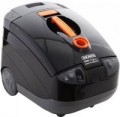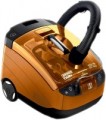Motor power
Rated power consumed by the vacuum cleaner. In models with power adjustment (see below), the maximum value is taken into account in this case. We are talking about the characteristics of the installed motor, which is the main, and in most vacuum cleaners, the only consumer of energy.
Higher power increases suction force and improves overall cleaning efficiency. In addition, a more powerful unit is easier to equip with a capacious dust collector. On the other hand, only vacuum cleaners of the same type with the same types of dust collectors can be directly compared by this parameter (see above for both). And even in such cases, the actual suction force (see below) may be different — and it is it that determines the real efficiency. However, the total power also allows you to generally evaluate the capabilities of the vacuum cleaner, including in comparison: a 1500 W model will significantly outperform its 800 W counterpart in efficiency (although it is impossible to say exactly by how much). But what definitely depends on this indicator is energy consumption.
As for specific power values, they are largely related to the type of device. For example, handheld models, robots and uproght units have low power —
less than 1500 W(and often noticeably less). Such values are quite popular among other types of vacuum cleaners (conventional, industrial, workshop, etc.), but among them there are already more solid indicators —
...f="/list/90/pr-1067/">1500 – 1750 W,
1750 – 2000 W and even
more than 2000 W.Suction power
The suction power provided by the vacuum cleaner. For models with power adjustment (see below), in this case, the maximum value is taken into account. Note that "suction power" is sometimes erroneously also called the suction force, indicated in pascals; see below for more details.
Suction power is a key indicator that determines the capabilities of the unit: the higher it is, the more efficiently the vacuum cleaner can draw in various contaminants, and the better it handles with carpets, fabrics and other materials into which dust can penetrate deeply. On the other hand, high power inevitably affects the weight, power consumption, dimensions and price of the device. Therefore, it does not always make sense to chase the maximum values — you need to take into account the real working conditions and the general purpose of the vacuum cleaner.
The specific numbers found in this paragraph largely depend on the type of device. For example, in handheld household models, suction power
does not exceed 100 W,
and for conventional household units, an indicator of 100 – 150 W is still considered very limited. At the same time, we note that the minimum required for a full-fledged dry cleaning of smooth floors is considered to be
300 – 350 W,
for carpet and other short pile coatings — 350 – 400 W, and for long pile materials and upholstered furniture
higher rates are desirable. Vacuum cleaners with lower suction power values are intended not so much for periodic cleaning, but for constant (ideally daily) maintenance of cleanliness in an already tidy room.
As for the relationship between suction power and suction force, it is as follows: power is the suction force (thrust) multiplied by the airflow (performance). Without going into too much detail, we can say that the efficiency of the vacuum cleaner is determined by both of these indicators. And it is worth evaluating this efficiency by suction power (regardless of the specific relationship between traction and performance).
Compatible bags (dust collectors)
Models of replacement bags and/or other containers for waste (see "Dust collector") with which the vacuum cleaner is compatible.
This moment does not affect the functionality of the vacuum cleaner itself. However, knowing the model of the dust collector makes it much easier to find a spare or replacement dust collector. At the same time, we note that compatible models of such containers may differ markedly in specifications from the ones in the box. For example, many fabric bag vacuum cleaners also accept disposable paper bags; and some units are initially equipped with a dust collector of one type. However, if desired, they allow you to buy and install a dust collector of another type (for example, replace the bag with an aquafilter).
Compatible HEPA filters
Models of HEPA filters that are suitable for installation in a vacuum cleaner.
This information is needed mainly to find new filters to replace clogged or worn ones. Theoretically, knowing the HEPA model you can find detailed data about it. However, such details are usually not required; information on the fine filter class is enough to select a vacuum cleaner.
Noise level
The noise level produced by the vacuum cleaner during operation. Usually, the value for normal operation at maximum engine power is indicated here. With less power, the loudness of the unit may be lower, but the key is precisely the maximum indicator.
Regarding specific numbers, keep in mind that the decibel used to measure the noise level is a non-linear quantity. Therefore, it is worth evaluating specific indicators using special comparative tables. In general, vacuum cleaners are quite noisy appliances; so in this case, models are considered quiet if this indicator
does not exceed 65 dB — this is the level of a loud conversation between 2 – 3 people at a distance of 1 m. The quietest of these models give out only 40 dB — this is the average volume of a person’s speech in normal tones (and the minimum volume allowed for constant noise sources in living quarters during the day). For louder units, the comparison table looks like this:
—
66 – 70 dB — loud conversations between several groups of people at a distance of about 1 m;
—
71 – 75 dB — the volume of a cry or laughter in full voice at a distance of about 1 m;
—
76 – 80 dB — the volume of a mechanical alarm clock or the engine of an old truck;
—
more than 80 dB — a very high noise level, exceeding the level of a loud scr
...eam; when working with a vacuum cleaner having such specifications for a long time, it is highly desirable to use hearing protection.
Also note that the noise level largely depends on the engine power, as well as some other features (for example, it is strongly affected by the presence of an aquafilter — see "Dust collector"). At the same time, there is no hard connection here, and units with a similar set of specifications can differ markedly in actual loudness. In such cases, when choosing here, it is worth proceeding from the fact that a quieter vacuum cleaner will be more comfortable to use. However, it will most likely cost noticeably more.Tube type
The type of rigid tube supplied with the vacuum cleaner.
The most popular are
telescopic tubes, extension tubes are much less common, and with some upright with handheld vacuum cleaners (see "Type"), tubes
with a hinge are supplied in the kit (they are also "bendable" or "flex"). Here is a more detailed description of each option:
— Telescopic tube. Non-separable tube folded telescopically — by inserting one section into another. This option is the most convenient from the user's point of view. Firstly, such accessories are easy to unfold and fold — just press or slide the release key and pull or push the halves in the right direction. Secondly, many telescopic tubes are equipped with a mechanism that allows the structure to be unfolded incompletely. Thanks to this, you can adjust the length during the cleaning process (for example, reduce it to work in cramped conditions). Thirdly, the individual parts of such a tube can't be lost, which simplifies storage. The main disadvantage of this option is considered to be somewhat lower strength and reliability than that of extension tubes. However, this difference is noticeable only at high loads. Thus, telescopic tubes are very popular in conventional vacuum cleaners (see "Type"), but they are found in other types, including industrial (construction). The “telescope” cannot be found in only three types of vacuum cleaners: in robots (they do no
...t use tubes), as well as, in industrial handheld units and fireplace models — they most often work only with a hose.
— Extension tubes. A tube consists of several parts connected during operation and disassembled for storage/transportation. Such designs are somewhat less convenient to use than telescopic ones, but they endure high loads much better and last longer. Thus, extension tubes are rarely used in conventional vacuum cleaners, but they are popular in professional units — industrial, workshop, etc.
— Bendable tube. A tube has a hinge in the middle and can bend at an upward angle. It is a rather specific option, used in some vacuum cleaners of the "upright with handheld" type. This design makes it much easier to clean with such a vacuum cleaner under sofas, beds, tables, etc. By bending the tube, you can effectively treat such places without lowering the vacuum cleaner body to the floor. On the other hand, the hinge significantly complicates the design and increases its cost, and far from all users, these disadvantages are outweighed by the mentioned ease of use. That is why this type of pipe is extremely rare.Power cord rewind
System of automatic
winding of a power cord. Usually, it is a special spool built into the body of the vacuum cleaner. To unwind a wire from such a spool, just pull it, and to rewind it, you need to press the button — and the built-in spring will twist the coil in the opposite direction, winding the cable around it.
The main advantage of the cord rewind system is obvious: it allows you to easily and quickly roll up the cable for storage and transport. In addition, in many vacuum cleaners with this function, the wire can be partially unwound, choosing its optimal length depending on the situation. The disadvantages of automatic cord rewind include some bulkiness and poor suitability for portable units. Such equipment nowadays can only be found among "full-size" vacuum cleaners — conventional (see "Type"), workshop and industrial.

